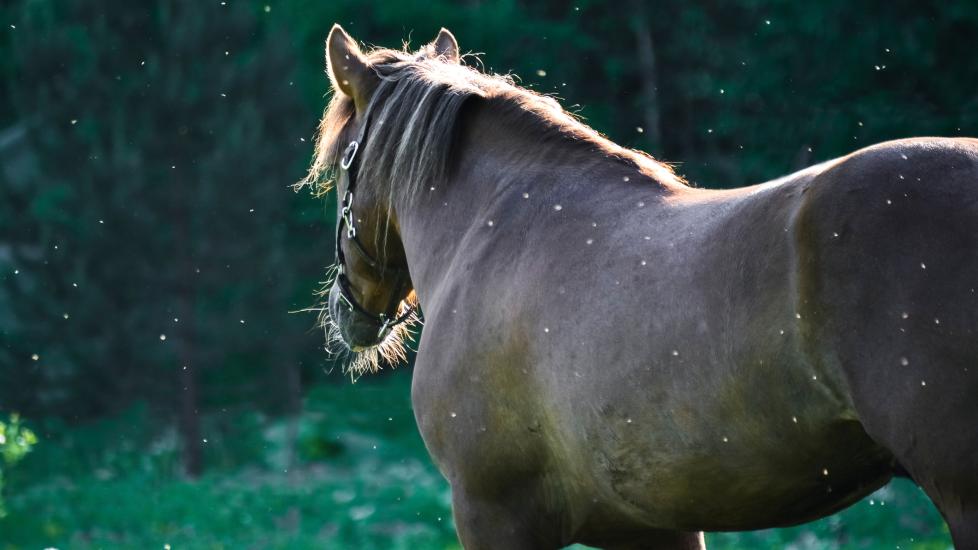Eastern Equine Encephalitis (EEE) in Horses
Sitikka/iStock / Getty Images Plus via Getty Images
What Is Eastern Equine Encephalitis?
Eastern equine encephalitis (EEE) in horses, also called sleeping sickness, is a viral disease caused by infected mosquitoes that most often leads to neurological problems and possible death if left untreated.
Horses, like humans, are considered “dead-end hosts” for the virus. This means the concentration of the virus in the bloodstream is inadequate or too low to infect mosquitoes or other animals if they were to interact with an infected EEE horse.
While all horses are at risk for EEE, young horses 6 months to 2 years old are particularly vulnerable due to their immature immune system.
Depending on the state you live in, EEE in horses may be reportable. Your veterinarian will contact appropriate health authorities if the horse’s EEE test comes back positive. If you suspect your horse may have signs of EEE, contact your vet immediately.
Symptoms of Eastern Equine Encephalitis
Symptoms of Eastern equine encephalitis in horses can vary but generally progress to neurological symptoms in infected horses.
Initial clinic signs may include the following:
-
Fever
-
Anorexia (not eating)
-
Stiffness
-
Lethargy
-
Depression
Clinical signs often progress to neurological signs including:
-
Aimless wandering
-
Impaired vision/blindness
-
Head pressing
-
Circling
-
Inability to swallow
-
Ataxia (poor muscle control)
-
Paresis (partial paralysis)
-
Full paralysis
-
Death
Causes of Eastern Equine Encephalitis
Wild birds tend to be the typical carrier for Eastern equine encephalitis, which is spread by a mosquito that has previously fed on a bird infected with EEE. The mosquito transmits the disease by biting a non-immune horse or human. EEE in horses spreads throughout the body and attacks the central nervous system (brain and spinal cord).
How Veterinarians Diagnose Eastern Equine Encephalitis
If you suspect your horse may have EEE, call your veterinarian immediately. They will do a complete physical and neurological exam.
If your veterinarian is concerned about EEE, they will recommend taking a blood sample and sending it to the lab for antibody testing. The blood test results generally come back in two to five days.
Treatment of Eastern Equine Encephalitis
Unfortunately, there is no cure for Eastern equine encephalitis and the disease has a high mortality rate with up to 90% of horses dying from the disease. Supportive care to keep an infected horse comfortable is often the goal of treatment. Horses that do survive may have permanent brain damage.
Your vet may prescribe a non-steroidal anti-inflammatory such as Banamine® (flunixin meglumine) to help reduce inflammation. Supportive care may also include intravenous fluids if a horse is unable to drink, and anticonvulsants such as phenobarbital if necessary.
In severe neurological cases a horse may need:
-
Sedation
-
Placement in a sling for support (if they are unable to stand)
Recovery and Management of Eastern Equine Encephalitis in Horses
Horses with EEE do not often survive. The morbidity rate is 75–95% and death usually occurs within two to three days from onset of clinic symptoms. If a horse were to survive they may have lasting neurological symptoms.
Prevention of Eastern Equine Encephalitis
The best prevention for EEE in horses is vaccination. All horses should stay up to date on the EEE vaccine.
Initially, an unvaccinated horse will be vaccinated, followed by a booster four to six weeks later. A yearly re-vaccination is recommended. More frequent boosters, such as twice a year, may be recommended in areas of year-round mosquito seasons and endemic areas. In the United States, EEE is most commonly found east of the Mississippi River, with Louisiana and Florida having the most reported cases last year.
Beside vaccination, good mosquito management can be helpful to prevent disease. Some best management techniques for mosquito control include:
-
Remove any sources of standing water on the property
-
Use fly masks, fly sheets, and fly leggings for horses when they are in turnout
-
Spray horses with insect repellent regularly
-
Keep horses inside during the hours of dawn and dusk, when mosquitoes are at peak feeding
-
Turn fans on in the barn for any stalled animals or allow barn windows to be open to encourage a breeze.
-
Always protect yourself by wearing insect repellent and wearing protective clothing
Eastern Equine Encephalitis FAQs
Where is Eastern equine encephalitis found?
Eastern equine encephalitis is primarily found in Eastern Canada, U.S. states east of the Mississippi River, and the Caribbean Islands.
Can humans get Eastern equine encephalitis?
Yes, humans can get EEE from an infected mosquito, but not from an infected horse.
Is Eastern equine encephalitis contagious?
No, EEE is not contagious to other horses or humans if one horse in the barn is infected.
References
Eastern Equine Encephalitis (EEE). Equine Disease Communication Center: Disease Factsheet. American Association of Equine Practitioners (aaep.org).
Vector-Borne Equine Encephalitides. US Department of Agriculture, Animal and Plant Health Inspection Service (usda.gov). 2024.
